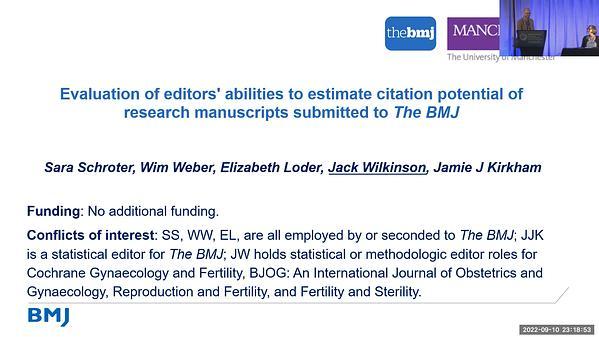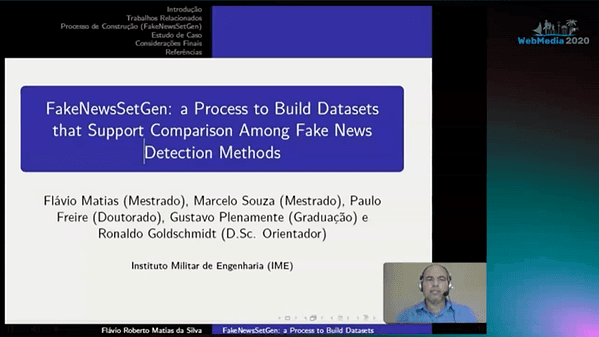Would you like to see your presentation here, made available to a global audience of researchers?
Add your own presentation or have us affordably record your next conference.
keywords:
online publishing
dissemination of information
social media
Objective Medical journals often use visual abstracts (VAs),
“infographics” designed to graphically convey a study’s
research question, methods, findings, and conclusions, to
summarize and promote published research on social media.
Studies suggest that VAs increase an article’s reach and
engagement, mostly demonstrated for individual journals on
Twitter.1-3 The JAMA Network, a family of 2 general medical
and 11 specialty journals, began creating VAs for randomized
clinical trials (RCTs) in 2018-2020 and publishing them
online and in social media. This study examined the
association of VAs with social media–driven site traffic and
metrics.
Design This random-sequence simultaneous crossover trial
included all RCTs published in the 13 JAMA Network journals
with an accompanying VA between September 21, 2021, and
May 15, 2022. For each, tweets and Facebook posts
promoting the RCT were published including a standard text
summary with a link to the online article, accompanied by 3
image display types: (1) preview VA, a VA thumbnail that
linked to the article when clicked; (2) expandable VA, a VA
thumbnail that expanded to full screen when clicked; and (3)
article image, an article figure or table thumbnail that linked
to the article (Facebook) or expanded to full screen (Twitter)
when clicked (control display). Three tweets and 3 Facebook
posts, 1 with each image display type, were published to
Twitter and Facebook nearly simultaneously (1 minute apart)
in random sequence within an hour of article publication. The
primary outcome was the number of link clicks by image
display type at 1 week. Secondary outcomes were social media
Twitter impressions/Facebook reach (how many times people
saw the tweet or post) and engagement (sum total number of
comments/replies, shares by other users, and likes) by image
display type at 1 week. The study was designed to provide
80% power to detect a 50% increase in median link clicks
comparing either of the 2 VA formats vs article image display.
Results Among 205 JAMA Network RCTs with VAs, link
clicks to full-text articles were higher with preview VAs vs
article images; impressions/reach and engagement were
higher with expandable VAs vs article image displays
(Table 24). In a preplanned subgroup analysis, the higher
link clicks appeared attributable to preview VA display on
Twitter (preview VA median, 12 IQR, 3-41 and expandable
VA median, 6 IQR, 2-21 vs article image median, 6 IQR,
1-21; P < .001) rather than Facebook (medians, 1 IQR, 0-14
and 3 IQR, 0-12 vs 1 IQR, 0-13, respectively; P = .11).

Conclusions In this random-sequence simultaneous
crossover trial, the use of visual abstracts in social media
posts was associated with higher social media–driven journal
site traffic when displayed as preview links, and higher social
media reach and engagement when displayed as expandable
images, compared with article images.
References
1. Oska S, Lerma E, Topf J. A picture is worth a thousand
views: a triple crossover trial of visual abstracts to examine
their impact on research dissemination. J Med Internet Res.
2020;22(12):e22327. doi:10.2196/22327
2. Ibrahim AM, Lillemoe KD, Klingensmith ME, Dimick JB.
Visual abstracts to disseminate research on social media: a
prospective, case-control crossover study. Ann Surg.
2017;266(6):e46-e48. doi:10.1097/SLA.0000000000002277
3. Chisari E, Gouda Z, Abdelaal M, et al. A crossover
randomized trial of visual abstracts versus plain-text tweets
for disseminating orthopedics research. J Arthroplasty.
2021;36(8):3010-3014. doi:10.1016/j.arth.2021.04.006
Conflict of Interest Disclosures N. Seth Trueger receives
salary support from the American Medical Association (AMA) for
his role as digital media editor, JAMA Network Open. Eman Aly
and Michael Berkwits are full-time employees of the AMA and the
JAMA Network. Sebastien Haneuse receives compensation from the
AMA for his role as statistical editor, JAMA Network Open. Michael
Berkwits is co-director of the Peer Review Congress but was not
involved in the review or decision for this abstract.


